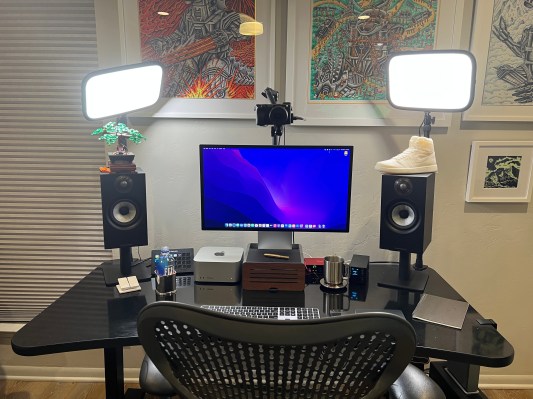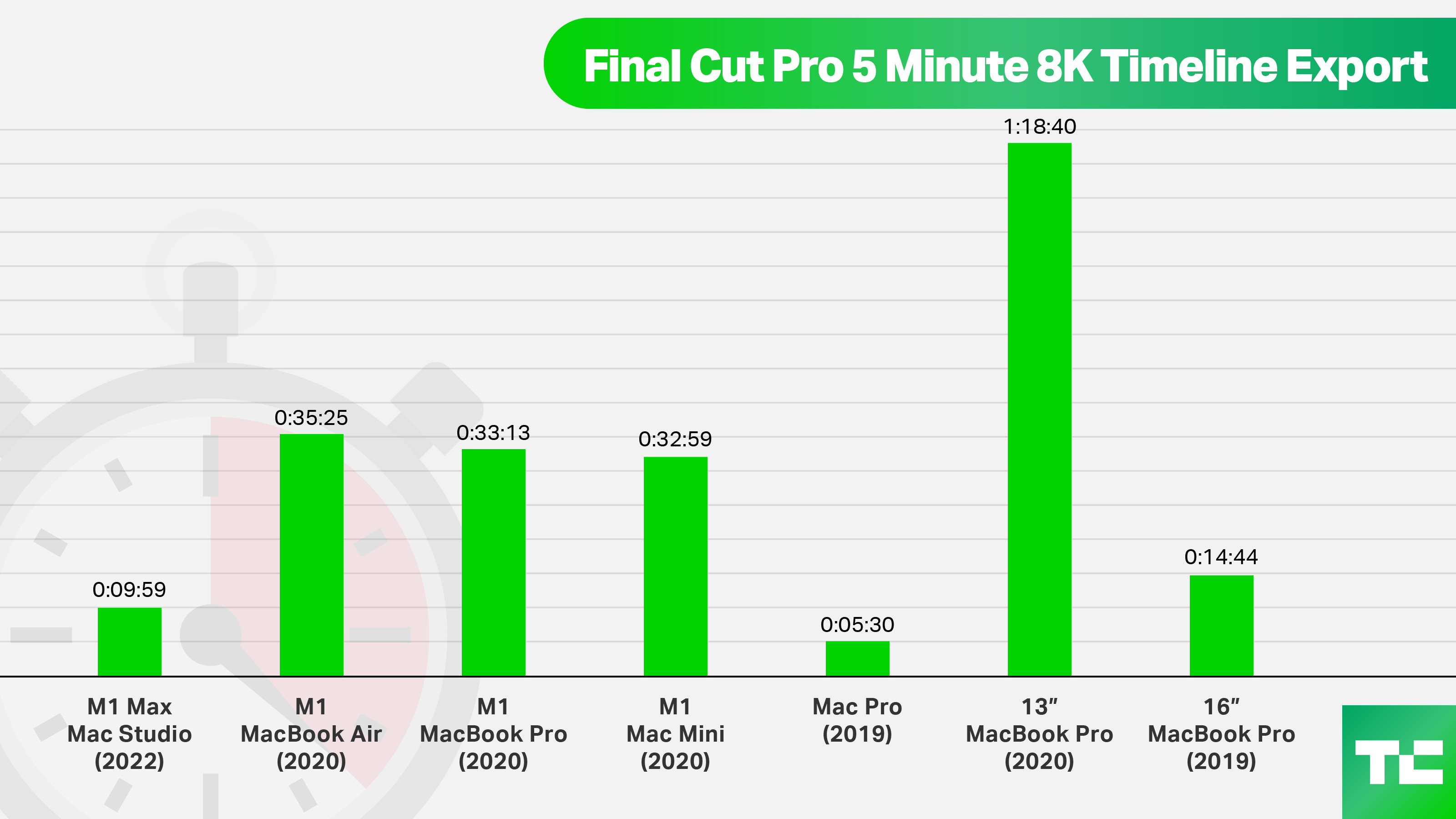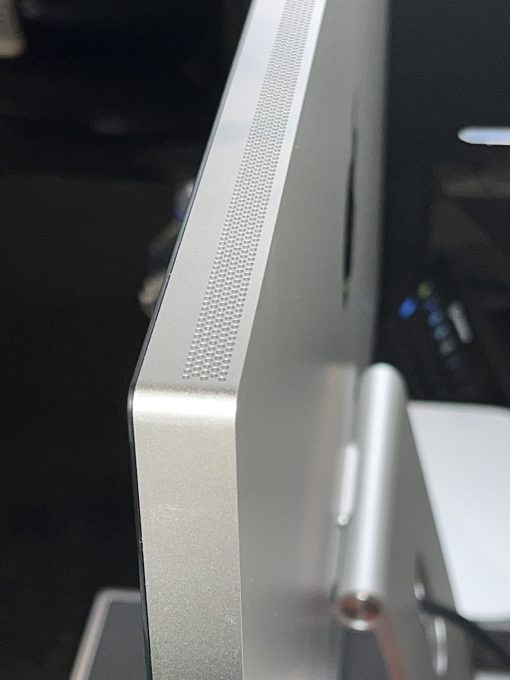The seeds of the Mac Studio were planted 5 years ago next month when, in a rare candid admission of misstep, Apple said it was pushing the reset button on the Mac Pro. Having painted itself into a “thermal corner,” Apple realized that it had to burn down the architecture it created and start anew.
One year later, it said that it had created the Pro Workflows Team, a group designed to interact with and gather information from professionals in creative, scientific and other fields to understand their work processes better. That information would go on to be used to develop 2019’s redesigned Mac Pro, a heavily modular system with some highly specialized optional components tailored to high end 3D design, music and film work.
The Mac Studio is also a child of that process, designed to introduce a brand-new kind of desktop to Apple’s lineup that combines pinnacle-level power, accessibility and port-rich extensibility with a modular approach that includes offering the Studio Display – designed alongside the Studio itself.
“We look very much at Mac studio for what it is, a completely new Mac product line. Which is rare. We don’t add product lines to the Mac very often,” says Tom Boger, Vice President of Mac & iPad Product Marketing at Apple. “Our philosophy was not at all to take a Mac Mini and scale it up, it was ‘we know we’re working on this M1 Ultra chip and we want to bring it to those users who want performance and conductivity and a modular system. And let’s allow it to live right on people’s desks so it’s within easy reach. And that’s what we delivered.”
I spoke to Boger, along with Shelly Goldberg, Senior Director, Mac & iPad Product Design and Xander Soren, Director of Product Marketing, Pro Apps at Apple about the design and development of Mac Studio.
In our convo, Soren noted that there was a clear signal from its creative and pro users that there was a need for a modular system that fell in between the iMac and the Mac Pro. Modular, in this sense, consisting of the Mac Studio offering two levels of M1 chip and a paired Studio Display.
There is a pretty clear throughline from Apple’s reset of the Mac Pro, to its formation of the Pro Workflows team to the development of Mac Studio. This is a port-rich offering that provides users with a lot of what they have been asking for both publicly on social media and in meetings with the workflow team.
The Mac Studio is a bit of an ode to Apple’s creative customer, the ones that kept Apple afloat through the lean years when they were pretty much the only users that saw the value in Apple’s approach to a design-forward suite of software and hardware offerings.
That group of Mac loyalists hasn’t always been treated to the rapid-fire releases that we’ve seen since 2019. For a while, that group was left to wonder whether Apple cared much about the Mac at all any more given the volcanic success of its iOS suite of products.
Even when the Mac Pro hit, there ended up being a lot more questions than answers given the eye-watering price and narrow market for such a beefy machine.
The Mac Studio fills in that gap (and a new gap left by the deletion, apparently permanently, of the 27″ iMac) between all-in-one and Mac Pro with an offering of a machine that can be paired with Apple’s monitor or any other. And the performance that it offers is absolutely undeniable.
I’ve had the Mac Studio for a week or so and have been using it, running benchmarks and pushing it in various ways, as well as just trying to see what this new shape of computing feels like to live with.
I’m happy to say that most of those impressions were positive – with one unfortunate exception that I’ll touch on later. I might mention a few here by the way, but if you want to see what kind of benchmark and testing results we got and a more in-depth hardware-centric look at Mac Studio, make sure to read TechCrunch Hardware Editor Brian Heater’s piece here.
In my testing, to cite one example, the Mac Studio with M1 Max that I am trying out clocked an 8K timeline export from Final Cut Pro that was 3x as fast as the 2020 M1 MacBook and only 3 minutes slower than a near-completely-maxed-out Mac Pro. The Mac Studio as configured will set you back around $3,200. Only around $20,000 cheaper than the Mac Pro I used to perform this test back in 2020.
This is an enormous performance delta, and one that Apple is leaning into hard with this offering for pros.
Soren says that peak performance of its pro apps is, for Apple, about democratization.
“When it comes to pro technologies, things can get expensive. You need a lot of different gear. You need a specific kind of professional space to work in. In the past you needed big teams,” says Soren. “All of that is really, really evolving. And I think that one reason that evolution is really accelerating the last couple years is because of Apple silicon.
We’re talking about how many screens you can have of 8k, or that you can do an Atmos mix in 96k audio, and the performance meter is hitting 30%. And the other very consistent thing we’re seeing is that you don’t need a super-expensive facility and long-term rent. We’re seeing incredible productions being done from a desk or the corner of a desk, and it’s pretty inspiring.”
Boger feels that it will take some time for people to orient themselves around having the option to have this separate desktop option available to choose from in Apple’s lineup. But Apple hopes these will become a cornerstone device in many studios and setups. In order for this machine to serve the needs of these more flexible workers, it had to provide optionality.
“I think the way we look at it is we’re happy to provide multiple ways for our users to work,” Boger says. “So you could decide to have a MacBook Pro with an M1 Max chip in it and you could decide to have a setup in your studio where you bring the MacBook Pro back and forth. And if that’s the way that you choose to work, great. But we also have users that prefer to have that desktop that always lives on their desk.”
The number of ports available on the Mac Studio is something that came out of talking to its pro customers, asking them how many devices that they’re using. The USB-A options were a bit surprising to me, to be honest, but Boger says that their research showed that there was still a legacy need.
“We’re trying to give our users that dynamic range of choice. So when deciding on the array of ports and how many and all of that it’s really just talking to lots of customers, serving our customers and seeing how many devices they’re using. And the USB-A ports is about the fact that people still have some legacy devices they can only connect there and there’s some software that still requires software keys,” Boger notes.
The Mac Studio, he says, was about giving them an extensive array of connectivity while still hitting what they feel like a sweet spot in number of ports for the vast majority of these kinds of users.
Another big design touchstone for the team building the Mac Studio was accessibility of those ports. The M1 Max (and theoretically M1 Ultra) are massively powerful chips that provide some of the best performance you can buy in any size of computer, much less one with a 7×7 footprint. But that compact size was also designed to make all of the ports accessible, even the ones in the back.
Being able to reach the front and even the back of the Mac Studio at any given moment was something that the team thought about when designing it. More than any mid-tower, the Mac Studio was truly designed to be a desktop desktop.
“We’ve got IO right on the front, and even if you need to get to the back, you just spin it around,” notes Boger. “It’s relatively light; it’s very small; it fits under most displays at 3.7 inches high. We’re really giving users something they’ve never had before. They’ve always had to trade off. If I wanted a smaller form factor computer, I had to trade off performance. And what we wanted to do was give people something where you don’t have to do that. In fact, you can do things no other computer can do like 18 streams of 8k video, or a massive 3D scene that takes up nearly 128 gigs of video memory.”
Fitting that kind of power into the Mac Studio was an engineering challenge, says Shelly Goldberg. The thermal situation alone was a huge endeavor that posed unique challenges from the Mac Pro where there was so much room for large fans and tons of venting.
Since the Mac Studio was designed to be a true desktop machine, Apple envisioned it operating close to the user.
“It was such a fun challenge from a hardware perspective, because we’re trying to deliver like this massive amount of performance, but were really constrained on the form factor,” says Goldberg. “Obviously, if you’re going to keep it on your desk, you don’t want it to be annoying you while you’re doing all those things, so it’s a really fun challenge from a hardware perspective. The team did hundreds of thermal simulations for the airflow to try to figure out what’s the best pattern of airflow through the system to try to optimize for performance and acoustics. And, ultimately, we came up with the the design that we have which has the inlet on the bottom coming in through over 2,000 machined holes that are all machined at [a specific] angle that rotates as you go around the perimeter.”
This special venting design reduces turbulence inside the casing, allowing air to flow smoothly from the bottom, over the components and through the blower without colliding with itself. The holes themselves are not drilled normally, either; there’s a custom designed Apple machine built specifically for this purpose that bores 3 holes per second in each casing at those specific angles.
The dual blower is completely non-standard, as well. Goldberg says that the engineering team found that by splitting each impeller of the blower by a divider partway up its height, they were able to make adjustments using the disc that allowed for different pitches of the blades above and below the divider.
“That results in drawing different amounts of airflow from each section of the box so we can tune for the thermal performance based on the cooling needs, adjust the height of that divider, adjust the the pitch of the blades and each section and then kind of optimize for thermals and acoustics at the same time,” says Goldberg. “Every generation – especially in the pro products – we feel like we’re pushing the envelope on thermal performance and what we can do to pack even more power density into a particular form factor. To find new ways to do that every generation is still pretty exciting for my team.”
The extra weight that some people noticed on the specs for the M1 Ultra model of Mac Studio, by the way, is from a lot of copper in the fin stack on top of the doubled-up SoC of the Ultra. The blower remains the same between the two models, tuned to each one’s needs, of course.
I personally found the thermal performance of the Mac Studio model that I had to be unbelievably good. Not only did I not notice even a hint of performance falloff in extended operations like renders or compiles, but I never heard the fans emit anything truly audible once. I’m sure some jobs will get it going enough to hear, but those will have to be pretty aggressive tasks.
The other component that makes the Mac Studio an attractive option for anyone, of course, is the Studio Display. The wait for a replacement for Apple’s extremely popular Thunderbolt Display has been a long one, indeed. Though the Pro Display XDR exists, and is one of the best monitors my eyes have ever seen – its $5,000 price point puts it out of the reach of many professionals who don’t need the reference monitor aspects of its feature set.
The Studio Display is excellent. No it is not micro-LED, but it is P3 and extremely crisp. Having the ability to run any of your Macs through this display after years of no target display mode on the iMac 27” is a really welcome option. Though the Studio Display was designed for Mac Studio, Apple is aware that you might run it on other machines. Which is why the A13 is on board doing the heavy lifting on Center Stage and Spatial Audio. It effectively gives older MacBooks a nice upgrade, as well as a crisp display.
“We wanted it to be a great, very accessible, very mainstream display for all of our Mac users,” says Boger. “It’s a great display if you want to hook up to the MacBook Pro, MacBook Air, Mac mini, Mac Studio, Mac Pro, whatever. And we know that there are still users out there who are using Intel-based Macs, and so putting A13 in there processes the audio for Spatial Audio and makes the magic of Center Stage happen.
While the Pro Display XDR is an amazing display and, we feel, the best display for pros anywhere – there are also millions of users out there that wanted Apple to offer a mainstream display for whatever Mac they’re on.”
For those of you wondering, by the way, you can use the display with non-Mac machines; it will light up as a regular display, webcam and set of stereo speakers.
Those speakers are the second big feature of the Studio Display, and I’m happy to report that I found them to sound quite good overall.
The max peak volume is roughly in the range of the 27” iMac, but with a far richer and broader tonality. The bass response is really impressive for a small chamber speaker array. Even though it’s “small bass,” you still feel it a bit at a distance which adds a little texture. The low end does still have that constrained feeling that is common to small chamber speaker setups, but the midrange is pleasantly broad and not tinny at all.
As far as Spatial Audio recordings are concerned, Studio Display presents a far broader downstage than I expected. When comparing the same track in spatial and non spatial, you know, you can hear the sound open up to a much more nuanced soundstage than the very vocal forward mixes common today.
I was pleasantly surprised to be able to hear it and enjoy it and actually mark the difference just with a casual listen. Though the sound can’t compare to my pair of dedicated on-desk monitors, it’s going to be better sound than most people have on their desktop now. Other people will probably have more educated opinions on it, but as far as I’m concerned, I think it’s pretty damn good. It’s a new high-water mark for monitor audio, hands down.
Goldberg says that the Spatial Audio system in the Studio Display also utilizes the force-canceling drivers that they built for the 16” MacBook Pro, a first for a desktop audio system. These specialized drivers provide an internal, oppositional force that dampens unwanted vibration, acting as a shock absorber that prevents the vibration of a speaker cone from traveling into the casing.
“I think that makes a really big difference in the quality of the sound because by having those opposing drivers, we’re sending all the vibration that we create into the intentional vibration that’s creating the sound instead of into the enclosure and shaking the enclosure in sometimes less predictable ways that creates side effects acoustically that are undesirable,” Goldberg notes.
Unfortunately, as you’ll also read in Brian’s review of the Mac Studio, we came across a big performance issue when it comes to the third marquee feature of Studio Display: the new Facetime camera.
In our testing, the Studio Display’s camera produces grainy, low-contrast and generally poor images both locally and remotely. The images that we’re seeing are, at this time, worse than the 2021 24” iMac’s camera produces.
I noticed the quality issues as soon as I fired up the webcam for the first time. I checked it with other devices and noticed that it was actually slightly better if it was running from a MacBook Pro running MacOS 12.2, though still not great. Given that there was a difference, my assumption was that it appeared to be some sort of processing error. I asked Apple if the results I had were typical, and sent sample images and video of what I was seeing. After review, an Apple spokesperson told me that the system was not behaving as expected and that Apple would be making updates to address the camera’s performance.
I do not have a timeline or any specifics on those updates, but Apple is now aware there is an issue with the Studio Display’s camera quality and they said they are working on fixes. It’s worth knowing this going into making your purchasing decisions, and could be a reason to wait to see if those updates improve the quality.
 As of now, it does not live up to the otherwise excellent performance of the display itself and the speakers, which set a new standard for in-monitor audio.
As of now, it does not live up to the otherwise excellent performance of the display itself and the speakers, which set a new standard for in-monitor audio.
When the Mac Pro dropped, I think there was a little bit of a sticker shock because people saw the lineup with the iMac at one end and the Mac Pro, which is really for a small segment of overall users, at the other. And a large valley in between – both in computing power and in price.
The Mac Pro fell victim to a phenomenon that I think explains a lot of chatter about pricing every time Apple releases a new machine. Much like the classic Porsche print ads of the 80s and 90s, much of Apple’s positioning is about how accessible its products are while simultaneously positioning them as objects of desire to be strived for.
They are aspirational products, to be sure, but the simple fact that you cannot buy a better iPhone than the best iPhone, and that billions of people own iPhones lends an air of the proletariat – and Apple’s own messaging, even in the interview above, is all about democratization.
That’s definitely an argument worth having about a roughly $3,000 work tool that is, by every measure, one of the most powerful consumer computers ever made. It’s a bit harder once that price tag hits $20,000. The truth is that, while we all love to imagine ourselves in the seat of one of those crazy powerful Mac Pros, the audience for that machine is vanishingly small when you compare it to the iPhone, iMac or iPad.
For that audience, the price tag is not really a big factor. For the rest of us, it kills the dream.
It’s a good problem to have. Every time Apple introduces a product it engenders a feeling of ‘how can I see myself in that Mac? The Mac Studio goes a long way toward filling a pricing and performance gap that caused some existential angst along with some professional frustration. It’s a fine machine and, if the webcam issues can be resolved with updates, the Studio Display is a worthy companion.
The desktop Mac is back.







